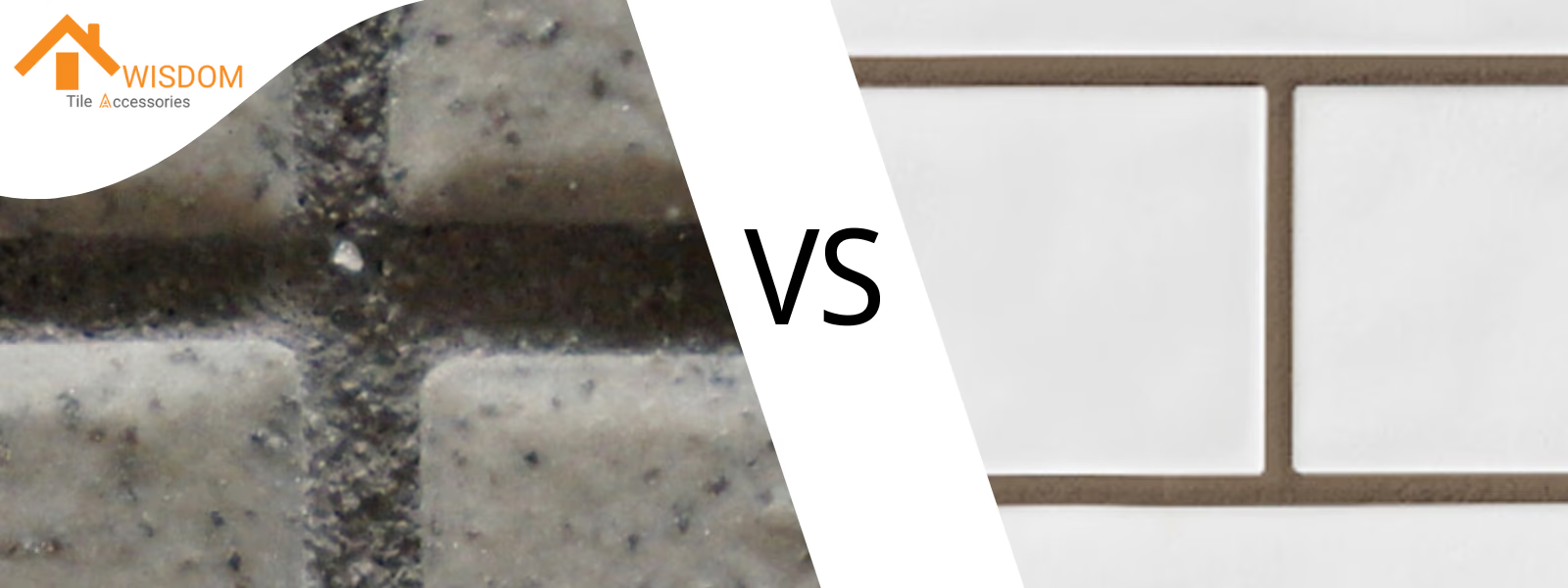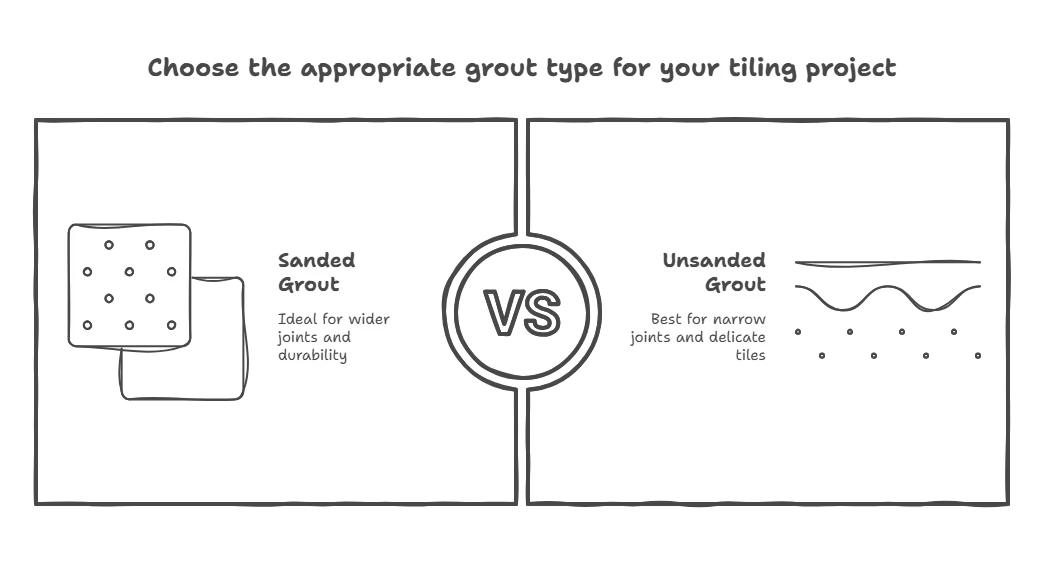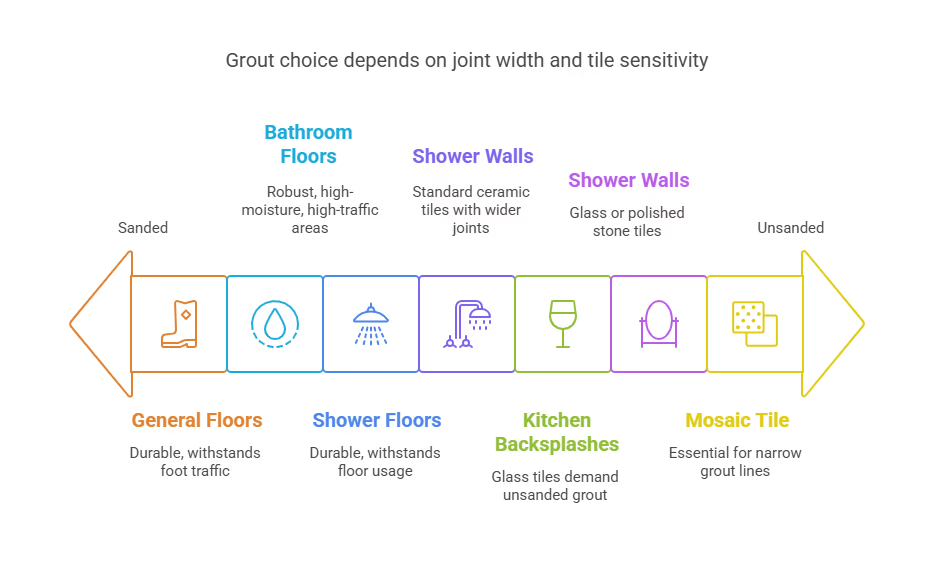Thinking about sanded vs unsanded grout for your tile? Whether it's for a shower, kitchen backsplash, or new floor, making the right grout choice is key. Many wonder about the actual difference between sanded vs unsanded grout and exactly when to use each. This guide explains it all, helping you pick the best grout for a great-looking, long-lasting tile job.

Understanding Grout
Grout is that essential material filling the spaces between your tiles, distinct from the mortar that sets them. But not all grout is the same. The main distinction comes down to one key ingredient: sand. This leads to the two basic types you'll encounter: sanded and unsanded grout. Knowing which to use, and when, starts with understanding what each one is.
What is Sanded Grout
Sanded grout is a cement-based grout with fine sand added to its mixture. This sand acts as a filler, providing bulk and preventing significant shrinkage as the grout cures. Its key characteristics include a somewhat gritty texture due to the sand particles, and notable strength and durability, making it suitable for wider grout joints.
- Composition: Cement, fine sand aggregates, pigments, and sometimes polymers.
- Characteristics: Gritty texture, high compressive strength, good for wider joints.
- Texture: Noticeably sandy or gritty to the touch.
- Strength: Robust and resistant to cracking in wider applications.
What is Unsanded Grout
Unsanded grout, as the name suggests, is also a cement-based grout but without the larger sand aggregates. It contains very fine mineral powders instead of sand, resulting in a much smoother consistency. This type is designed for narrower grout joints where sanded grout might be too coarse to fill effectively or could potentially scratch delicate tile surfaces.
- Composition: Cement, very fine mineral powders, pigments, and often polymers.
- Characteristics: Smooth texture, less abrasive, ideal for narrow joints and delicate tiles.
- Smoothness: Offers a fine, smooth finish when cured.

Sand Content and Grout Joint Size
The presence or absence of sand directly influences the recommended grout joint size. It's a fundamental rule in tiling:
- Sanded grout is generally used for grout joints that are 1/8 inch wide or larger. The sand provides the necessary body to fill these wider gaps without excessive shrinkage.
- Unsanded grout is typically reserved for narrower grout joints, usually from 1/16 inch up to 1/8 inch wide. Its finer particles allow it to pack densely into these small spaces.
This 1/8-inch mark is a widely accepted guideline, similar to how industry standards like those from ANSI (American National Standard Institute) dictate appropriate applications for different tile and installation materials. Forcing the wrong type of grout into an incorrectly sized joint is a common cause of grout failure.
Sanded Grout Overview
Sanded grout has long been a go-to choice for many tiling projects, primarily due to its strength and suitability for wider grout lines. Understanding its specific benefits and drawbacks, alongside knowing the ideal situations for its use, is key to a successful installation.
Advantages and Disadvantages of Sanded Grout
Advantages | Disdvantages |
|---|---|
Excellent durability and resistance to shrinkage | Can scratch delicate or polished tile surfaces |
Provides structural integrity for wider joints | Not suitable for very narrow grout joints (< 1/8 inch) |
Less prone to cracking in wide applications | Sand particles can make packing narrow joints difficult |
Generally more budget-friendly | Gritty texture may not be desired for all finishes |
Often sufficient for standard residential use | Can create voids if not packed well in narrow joints |
When to Use Sanded Grout
Given its characteristics, sanded grout is the recommended choice for:
- Flooring: It's excellent for floor tile installations, including ceramic, porcelain, and durable natural stone that isn't prone to scratching. Floors generally have wider grout joints and experience more wear, making sanded grout's strength beneficial. This is a common consideration when choosing grout for floor tile.
- Grout Joints Wider Than 1/8 Inch: This is a fundamental rule. If your grout lines are 1/8 inch up to 5/8 inch (or even wider, depending on the specific product), sanded grout is almost always the correct option to ensure a solid, crack-resistant fill.
Unsanded Grout Overview
Unsanded grout offers a smoother alternative, designed specifically for applications where sanded grout might be problematic. Its unique properties make it ideal for certain types of tile and joint sizes.
Advantages and Disadvantages of Unsanded Grout
Advantages | Disadvantages |
|---|---|
Smooth texture, safe for delicate/polished surfaces | Prone to shrinkage/cracking in joints wider than 1/8 inch |
Adheres well in very narrow grout joints | Lacks structural stability for very wide applications |
Easier to work into tight spaces (1/16" to 1/8") | Generally less wear-resistant than sanded for high-traffic |
Prevents scratching on sensitive tiles (glass, etc.) | May be slightly more expensive than basic sanded grout |
Contributes to a sleeker aesthetic on walls | Not ideal if significant structural fill is needed |
When to Use Unsanded Grout
You should opt for unsanded grout in these situations:
- Wall Tiles, Showers, and Backsplashes (with delicate tiles or narrow joints): It's a frequent choice for wall tile, especially when working with glass tiles, polished stone, or glossy ceramics to prevent scratching. This applies to shower walls and kitchen backsplashes, considerations often discussed when selecting grout for a shower wall or a kitchen backsplash.
- Mosaic Tiles: Mosaic tile installations often feature very narrow and intricate grout lines where unsanded grout's fine texture is essential for proper filling. When considering grout for mosaics, the choice almost always leans towards unsanded.
- Vertical Surfaces: Its smoother consistency can make it easier to apply and achieve a clean finish on vertical installations.
- Grout Joints 1/8 Inch or Narrower: This is its primary application range. For joints between 1/16 inch and 1/8 inch, unsanded grout is the standard.
Choosing Between Sanded and Unsanded Grout
Making the right grout choice doesn't have to be complicated. It primarily boils down to a few key practical considerations related to your specific tile project. If you weigh these factors carefully, you'll arrive at the best option – sanded or unsanded – for your needs.
Grout Joint Width Considerations
This is often the first and most decisive factor. As we've touched on:
- Joints wider than 1/8 inch generally require sanded grout. The sand provides the necessary body to fill these larger gaps effectively and resist cracking from shrinkage.
- Joints 1/8 inch or narrower are best suited for unsanded grout. Its finer particles can pack densely into these tight spaces for a solid fill.
The rationale is straightforward: using unsanded grout in wide joints can lead to excessive shrinkage and cracking as it cures. Conversely, trying to force coarse sanded grout into very narrow joints can result in poor compaction, voids, and an uneven finish. Always check the grout manufacturer's specific recommendations, as some high-performance products might have slightly different guidelines, but the 1/8-inch rule is a solid starting point.
Tile Material and Scratch Sensitivity
The type of tile you're installing is another critical factor.
- For delicate surfaces like glass tiles, polished marble or other polished natural stone, and some high-gloss ceramic or porcelain tiles, unsanded grout is almost always the safer choice to prevent scratching during installation.
- For most standard ceramic tiles, unpolished porcelain, quarry tile, and more robust natural stones that aren't prone to scratching, sanded grout is perfectly acceptable and often preferred for its durability, especially if joint widths allow.
- Subway tile installations can vary; if using traditional subway tiles with very narrow joints, unsanded might be used. However, some installations use wider joints, which would then call for sanded grout, assuming the tile surface isn't overly delicate.
Always test on a spare tile if you're unsure about potential scratching.
Installation Area Impact
Where the tile is being installed also influences the grout choice:
- Floors: Generally, floors see more traffic and potential wear. If joint widths allow and the tile isn't delicate, sanded grout is often favored for its superior durability. This is especially true for high-traffic areas.
- Walls: For wall applications, particularly in areas like kitchen backsplashes or decorative features, the choice often leans towards unsanded grout if narrow joints or delicate tiles are involved, prioritizing a smooth finish and scratch prevention.
- Showers: This is a common area of concern.
- For shower floors, durability and water resistance are key. Sanded grout is often used if joint widths permit, ensuring a robust surface.
- For shower walls, if using delicate tiles like glass or polished stone, or if joints are very narrow, unsanded grout is typically preferred to prevent scratches and ensure good fill.
- Kitchen Backsplashes: Similar to shower walls, tile type and joint width are primary drivers. Glass or other delicate tiles will necessitate unsanded grout.
- Bathrooms (general): Considerations for bathroom floors and walls mirror those mentioned above, always balancing durability, water exposure, tile type, and joint width.
Desired Finish and Final Texture
Finally, consider the aesthetic you want to achieve.
- Sanded grout will have a slightly coarser, more traditional textured appearance.
- Unsanded grout provides a smoother, finer finish.
For some, this textural difference can be a deciding factor, especially in highly visible areas or where a very sleek, modern look is desired.
Grout Application by Specific Area
Let's briefly summarize the typical grout choices for common tiling projects, keeping the above factors in mind. Remember, these are general guidelines; always defer to your specific tile, joint width, and grout manufacturer recommendations.

Grout Selection for Shower Floors
Often sanded grout due to wider joints typically found on floors and the need for durability. However, if very narrow joints or extremely delicate (though less common for floors) tiles are used, a high-performance unsanded grout with excellent sealing might be considered.
Grout Selection for Shower Walls
Frequently unsanded grout, especially if using glass, polished stone, or other scratch-sensitive tiles, or if aiming for very narrow grout lines (1/8 inch or less). If using standard ceramic tiles with wider joints, sanded grout could be an option.
Grout Selection for Kitchen Backsplashes
The tile material is a major driver here. Glass tiles, popular for backsplashes, demand unsanded grout. For standard ceramic or porcelain with wider joints, sanded grout is viable if the surface isn't prone to scratching.
Grout Selection for General Floor Tiling
Sanded grout is the workhorse for most floor tile installations due to its strength, durability against foot traffic, and suitability for the typically wider grout joints used with floor tiles.
Grout Selection for Bathroom Floors
Similar to general floor tiling, sanded grout is commonly preferred for its robustness in this often high-moisture, high-traffic area, provided the tile and joint width are appropriate.
Grout Selection for Mosaic Tile Projects
Unsanded grout is almost exclusively used for mosaic tiles. Mosaics, by their nature, have very small, intricate pieces and correspondingly narrow grout lines, making unsanded grout's fine texture essential for proper application and a clean look.
Exploring Other Grout Types
Beyond the common sanded and unsanded cement grouts, a couple of other options deserve attention, especially if your project has specific performance needs.
Epoxy Grout Explained
Epoxy grout isn't your typical cement-based product. It's a resin system, usually mixed from two or three parts right before use. This mixing starts a chemical reaction giving epoxy its standout qualities.
It’s known for extreme durability, being virtually waterproof, and offering high stain and chemical resistance. This makes it a top pick for tough environments. Plus, epoxy doesn't need sealing. The main trade-offs? It costs more and is trickier to apply. Epoxy has a limited working time and cleaning it off tiles requires care. Pros often handle epoxy jobs. You'll see it in commercial kitchens, labs, showers (especially steam rooms), and homes needing top-tier stain and moisture defense, like on kitchen counters or busy bathroom floors. Many now consider epoxy the go-to for high-performance tiling.
Pre-Mixed Grout Information
Pre-mixed grouts offer out-of-the-bucket convenience, saving you from mixing powders and water.
Their big plus is ease of use, ensuring consistent color and reducing errors for DIYers. You can find pre-mixed options that act like traditional sanded or unsanded grouts, and some even offer advanced resin benefits. Just check the product specs for its intended use – joint width, wet area suitability, and so on. While handy, some pros stick with traditional grouts for certain jobs, citing long-term track records or specific site needs.
Important Grouting Advice
Choosing the right type of grout is just the start. A few other tips will help your tile work look its best and last.
The Necessity of Grout Sealing
Traditional cement grouts – both sanded and unsanded – are porous. They absorb water and can stain. Sealing them with a quality penetrating sealer is a good move. It protects against discoloration, makes cleaning easier, and can deter mold and mildew. Sealing can also help mitigate issues like grout efflorescence, a common problem with cement-based products.
However, epoxy grouts and some advanced pre-mixed types usually don't need a sealer; sealing might even harm them. Always follow the grout maker's specific sealing advice.
Grout Color Selection Guidance
Grout color dramatically changes how your tile looks.
- A matching grout color blends in, making the tiles the star and creating a uniform surface.
- A contrasting grout color makes each tile and the pattern stand out. Think of classic subway tile installations.
- Consider practicality too. Lighter grouts show dirt more easily than darker ones, especially on floors. Think about the area's use and how much cleaning you're up for.
Professional Grout Selection Insights
If you're unsure, talk to a qualified tile installer or a knowledgeable supplier. They look beyond just joint width and tile type, considering site conditions, expected wear, and your long-term hopes for the project. They also keep up with the latest products and industry best practices, like the standards from groups such as the TCNA (Tile Council of North America).
Final Recommendations for Grout Selection
Picking the right grout – sanded, unsanded, or even an epoxy or pre-mixed type – comes down to your project's specific demands.
- Know your key factors: What type of tile are you using (is it delicate)? How wide will the grout joints be (over or under 1/8 inch)? Where is it being installed (floor, wall, shower, high traffic)? Your answers here will point you to the best grout.
- Function over pure aesthetics: A super-thin grout line might look good, but if your tile or joint width isn't right for it, the installation could fail.
- Read the manufacturer's instructions. Each grout product is a bit different. Their directions are your top resource for application, cure times, and sealing.
An informed grout choice isn't just about filling gaps. It ensures your whole tile installation looks great, stays durable, and lasts for years. Get this right, and your grout will be the perfect partner to your tiles.
Frequently Asked Questions (FAQ)
Should I use sanded or unsanded grout for porcelain tile?
For porcelain tile, the choice between sanded and unsanded grout primarily depends on the grout joint width. If your grout joints are 1/8 inch or wider, sanded grout is typically recommended for its durability. If the joints are narrower than 1/8 inch, or if the porcelain tile has a very delicate, easily scratched polished finish (though less common), unsanded grout would be appropriate.
What is the best type of grout to use in a bathroom?
The best grout for a bathroom depends on the specific application area (floor, walls, shower) and tile type. For bathroom floors with wider joints, sanded grout is often preferred for durability. For shower walls with delicate tiles or narrow joints, unsanded grout is common. Epoxy grout is also an excellent choice for bathrooms, especially showers, due to its high water and stain resistance, though it's more expensive and harder to apply.
Does unsanded grout need to be sealed?
Yes, traditional cement-based unsanded grout is porous and should be sealed to protect it from water absorption, stains, and mildew growth. Sealing makes it easier to clean and prolongs its life. Some advanced pre-mixed unsanded grouts or epoxy grouts do not require sealing; always check the manufacturer's instructions.
Which grout is best for a kitchen backsplash?
For a kitchen backsplash, unsanded grout is often the best choice, especially if you are using delicate tiles like glass, polished stone, or tiles with a high-gloss finish that could be scratched by sand. If your backsplash tiles are standard ceramic with joints wider than 1/8 inch and aren't prone to scratching, sanded grout could be used.
Can I use sanded grout on glass tiles?
No, it is generally not recommended to use sanded grout on glass tiles. The sand particles in sanded grout can easily scratch the surface of glass tiles during application and cleanup. Unsanded grout is the appropriate choice for glass tile installations to maintain their appearance.
What grout joint width requires sanded grout?
Sanded grout is generally required for grout joints that are 1/8 inch wide or larger. The sand provides the necessary aggregate to fill these wider spaces effectively and prevent excessive shrinkage or cracking.
Is unsanded grout waterproof?
No, standard cement-based unsanded grout is not inherently waterproof. It is porous and will absorb water unless it is properly sealed with a penetrating grout sealer. For a truly waterproof grout, epoxy grout is the best option.
What is the main difference between sanded and unsanded grout?
The main difference is the presence of sand. Sanded grout contains fine sand aggregates, making it suitable for wider joints (1/8" or more) and providing strength. Unsanded grout does not contain sand (or contains very fine powders instead), making it smooth, suitable for narrow joints (less than 1/8"), and safe for delicate tile surfaces.


